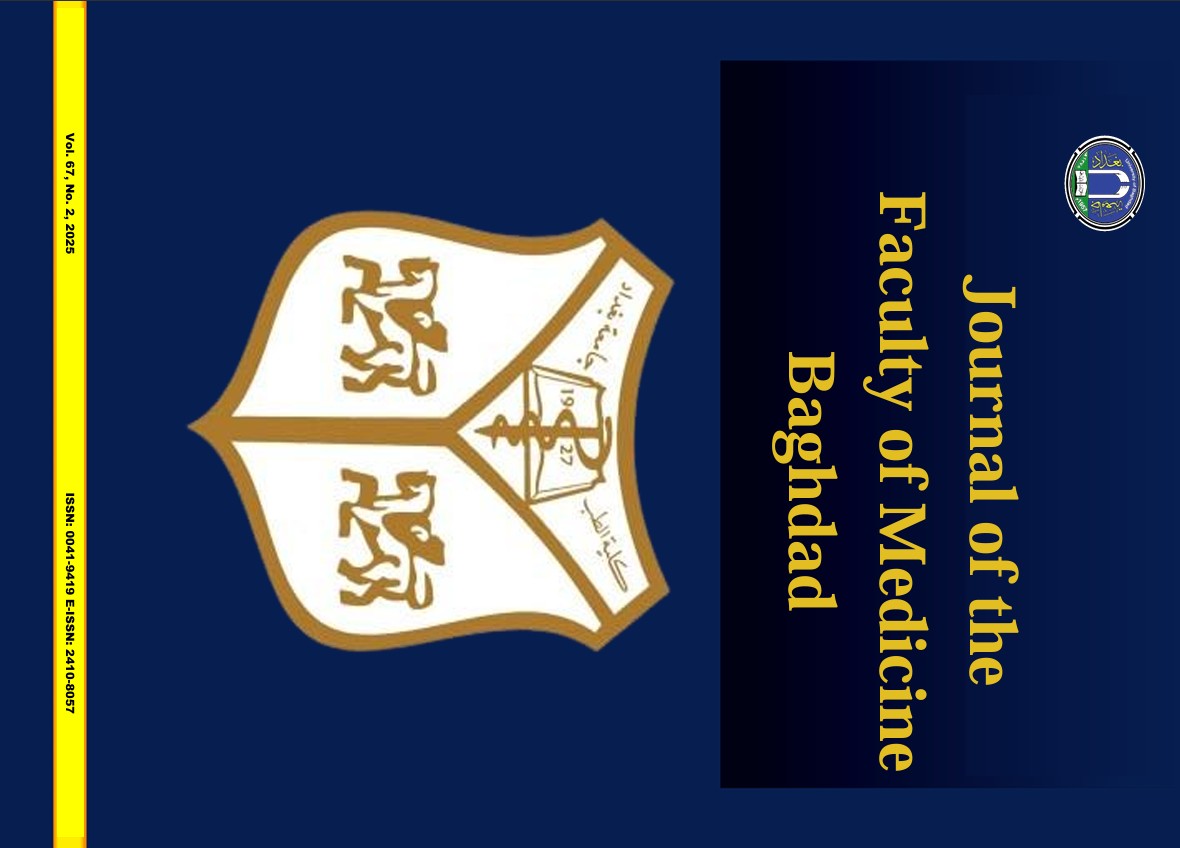Abstract
Background: Between 0.3% and 2% of pregnant women experience hyperemesis gravidarum. It is recognized by persistent and unexplained vomiting and dehydration, and the diagnosis is confirmed by significant loss of weight, usually more than 5% of the pre-pregnancy weight. Tumor necrosis factor-α is a multipotent cytokine that affects a vast array of cells. It is now well accepted that the tumor necrosis factor-α is crucial in the very early stages of pregnancy.
Objectives: To assess the relationship between the tumor necrosis factor-α and hyperemesis gravidarum.
Methods: This case-control study was carried out at the Baghdad Teaching Hospital, Obstetrics and Gynecology Department, from 1 January to 1 November 2022. The study involved 50 pregnant women, who suffered from hyperemesis gravidarum (mild or severe) as the case group, and another 50 healthy pregnant women as the control group, in the first trimester. The (Pregnancy-Unique Quantification of Emesis and Nausea) Index was used to evaluate the severity of the symptoms . Five milliliters of venous blood were taken to measure the tumor necrosis factor-α.
Results: In contrast to the women in the control group, pregnant women with hyperemesis gravidarum had a mean hemoglobin that was significantly lower (10.8) g/dL compared to the control group (11.5) g/dL and their liver enzymes were significantly higher except for alkaline phosphatase, (294.4) IU/L compared to the control group (49.5) IU/L. Their mean tumor necrosis factor-α level was also significantly higher, (200.6) pg/ml versus (96.34) pg/ml in the control group.
Conclusion: The mean tumor necrosis factor-α level was higher in patients with hyperemesis gravidarum than in women with normal pregnancy.
Objectives: To assess the relationship between the tumor necrosis factor-α and hyperemesis gravidarum.
Methods: This case-control study was carried out at the Baghdad Teaching Hospital, Obstetrics and Gynecology Department, from 1 January to 1 November 2022. The study involved 50 pregnant women, who suffered from hyperemesis gravidarum (mild or severe) as the case group, and another 50 healthy pregnant women as the control group, in the first trimester. The (Pregnancy-Unique Quantification of Emesis and Nausea) Index was used to evaluate the severity of the symptoms . Five milliliters of venous blood were taken to measure the tumor necrosis factor-α.
Results: In contrast to the women in the control group, pregnant women with hyperemesis gravidarum had a mean hemoglobin that was significantly lower (10.8) g/dL compared to the control group (11.5) g/dL and their liver enzymes were significantly higher except for alkaline phosphatase, (294.4) IU/L compared to the control group (49.5) IU/L. Their mean tumor necrosis factor-α level was also significantly higher, (200.6) pg/ml versus (96.34) pg/ml in the control group.
Conclusion: The mean tumor necrosis factor-α level was higher in patients with hyperemesis gravidarum than in women with normal pregnancy.
Keywords
Assessment،
hyperemesis
Tumor necrosis factor-α;
women
Abstract
خلفية البحث: يحدث القيء الحملي لدى 0.3% إلى 2% من النساء الحوامل. ويُشخص بالقيء المستمر وغير المبرر والجفاف، ويُؤكد التشخيص بفقدان الوزن بشكل ملحوظ، عادةً أكثر من 5% من وزن ما قبل الحمل. يُعد عامل نخر الورم- ألفا سايتوكينًا قويًا متعدد القدرات، يتمتع بنطاق واسع من التأثيرات على مجموعة كبيرة ومتنوعة من الخلايا. وقد تراكمت أدلة كثيرة تدعم فكرة أن عامل نخر الورم- ألفا يلعب دورًا أساسيًا في المراحل المبكرة جدًا من الحمل.
هدف الدراسة: تقييم العلاقة بين القيء الحملي وعامل نخر الورم- ألفا.
المنهجية: هذه دراسة حالة وشاهد أجريت في قسم التوليد وأمراض النساء في مستشفى بغداد التعليمي خلال الفترة من 1 كانون الثاني إلى 1 تشرين الثاني 2022. شملت الدراسة 50 امرأة حاملاً يعانين من فرط القيء الحملي (خفيف أو شديد) كمجموعة حالة. و50 امرأة حامل أخرى سليمة كمجموعة ضابطة في الأشهر الثلاثة الأولى من الحمل. تم استخدام مؤشر PUQE (القياس الكمي الفريد للقيء والغثيان أثناء الحمل) لتقييم شدة الأعراض. تم أخذ خمسة مل من الدم الوريدي لقياس عامل نخر الورم- ألفا.
النتائج:- في النساء الحوامل المصابات بفرط القيء الحملي، كان متوسط الهيموغلوبين أقل بشكل ملحوظ، (10.8) غم\\\\\\\\دل مقارنة بالمجموعة الضابطة (11.5) غم\\\\\\\\دل , وكانت إنزيمات الكبد أعلى بشكل ملحوظ في النساء الحوامل المصابات بفرط القيء الحملي باستثناء الفوسفاتيز القلوي (294.4) وحدة دولية\\\\\\\\ل مقارنة بالمجموعة الضابطة (49.5) ) وحدة دولية\\\\\\\\ل ، وكان مستوى عامل نخر الورم- ألفا أعلى بشكل ملحوظ (200.6) pg/ml مقابل (96.34) pg/ml في المجموعه الضابطة.
الإستنتاج: كان متوسط مستوى عامل نخر الورم- ألفا أعلى لدى المريضات المصابات بفرط القيء الحملي مقارنةً بالحمل الطبيعي.
هدف الدراسة: تقييم العلاقة بين القيء الحملي وعامل نخر الورم- ألفا.
المنهجية: هذه دراسة حالة وشاهد أجريت في قسم التوليد وأمراض النساء في مستشفى بغداد التعليمي خلال الفترة من 1 كانون الثاني إلى 1 تشرين الثاني 2022. شملت الدراسة 50 امرأة حاملاً يعانين من فرط القيء الحملي (خفيف أو شديد) كمجموعة حالة. و50 امرأة حامل أخرى سليمة كمجموعة ضابطة في الأشهر الثلاثة الأولى من الحمل. تم استخدام مؤشر PUQE (القياس الكمي الفريد للقيء والغثيان أثناء الحمل) لتقييم شدة الأعراض. تم أخذ خمسة مل من الدم الوريدي لقياس عامل نخر الورم- ألفا.
النتائج:- في النساء الحوامل المصابات بفرط القيء الحملي، كان متوسط الهيموغلوبين أقل بشكل ملحوظ، (10.8) غم\\\\\\\\دل مقارنة بالمجموعة الضابطة (11.5) غم\\\\\\\\دل , وكانت إنزيمات الكبد أعلى بشكل ملحوظ في النساء الحوامل المصابات بفرط القيء الحملي باستثناء الفوسفاتيز القلوي (294.4) وحدة دولية\\\\\\\\ل مقارنة بالمجموعة الضابطة (49.5) ) وحدة دولية\\\\\\\\ل ، وكان مستوى عامل نخر الورم- ألفا أعلى بشكل ملحوظ (200.6) pg/ml مقابل (96.34) pg/ml في المجموعه الضابطة.
الإستنتاج: كان متوسط مستوى عامل نخر الورم- ألفا أعلى لدى المريضات المصابات بفرط القيء الحملي مقارنةً بالحمل الطبيعي.
Keywords
تقييم، عامل نخر الورم الفا، فرط قيئ، نساء
